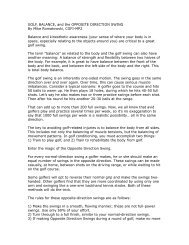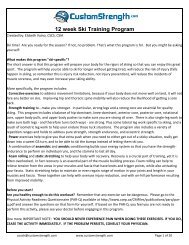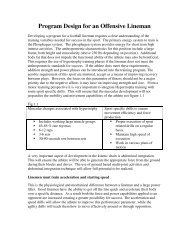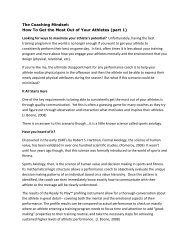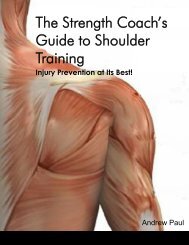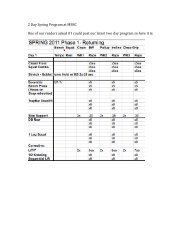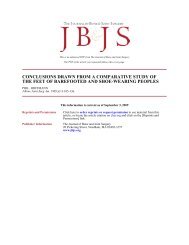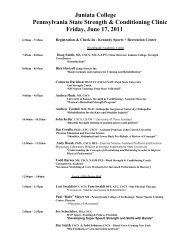Sprint Interval Training - “It's a HIIT - Strength Coach.com
Sprint Interval Training - “It's a HIIT - Strength Coach.com
Sprint Interval Training - “It's a HIIT - Strength Coach.com
You also want an ePaper? Increase the reach of your titles
YUMPU automatically turns print PDFs into web optimized ePapers that Google loves.
Introduction<br />
By <strong>HIIT</strong>, I do not mean that it is popular (although, finally and thankfully, it is certainly be<strong>com</strong>ing so), but<br />
rather, that sprint interval training (SIT) is also referred to as high‐intensity interval training or <strong>HIIT</strong>. It is of major<br />
importance that health care professionals make sure that the general public, as well as many contemporaries, get<br />
thoroughly educated about the superior health and fitness benefits of SIT, or “burst” training, as <strong>com</strong>pared to low‐<br />
to moderate‐intensity continuous training (LMICT). This is because, despite research to the contrary, most people<br />
still believe that to develop a healthy heart and to lose weight, the best mode of exercise is long and continuous<br />
“cardio” exercise, which, inherently, requires a significant investment of time. And, of course, lack of time is the<br />
number one excuse given for not <strong>com</strong>plying with an exercise program. Before getting into the health and fitness<br />
benefits of SIT or <strong>HIIT</strong>, I want to make some clarifications about the definitions and also make a few <strong>com</strong>ments<br />
about training for individuals that want to take part or <strong>com</strong>pete in endurance events.<br />
<strong>Interval</strong> training refers to intermittent exercise involving periods of exercise followed by periods of<br />
recovery, which enables anyone to increase the intensity of the exercise workload. A pretty simple concept. The<br />
problem, however, with the term “high‐intensity” is that it is descriptive and, obviously, relative to an individual’s<br />
level of fitness and dependant upon one’s tolerance to exertion. Running at five miles per hour may be an all‐out<br />
effort for some, whereas, it may be a walk in the park for others. While it is easy to assign relative exercise<br />
intensities for both training and research purposes by first measuring maximal capacities, one also needs to<br />
understand that the term “high‐intensity” is used in the scientific literature to describe intensities ranging from as<br />
low as 85% of maximal oxygen uptake (VO 2 max or aerobic capacity) to as high as 250%. These intensities also<br />
need clarifying for people who incorrectly assume that 100% VO 2 max indicates an all‐out effort, which is not the<br />
case; if it did, studies could not prescribe intensities above 100% VO 2 max. These exercise intensities are related to<br />
the maximal workload achieved when measuring an individual’s VO 2 max in a progressively‐graded exercise stress<br />
test that can last for 10 or more minutes. This is not the same as asking someone to sprint as fast as they can for,<br />
say, 20 seconds; the workload or speed, in this case, would be considerably higher than the workload<br />
corresponding to 100% VO 2 max. For example, if the workload on a treadmill eliciting VO 2 max was 8 mph at a 5%<br />
1



